Aquarium snails have sometimes been viewed as detrimental to freshwater aquariums, but this is not always an accurate assessment.
Some snails are quite beneficial to freshwater aquariums. These snails are usually quite popular among aquarists. They have very few demands and are exciting to observe. Moreover, aquarium snails feed on algae and help to keep your tank clean.
However, to take the best care of them, it’s important to know about their diet, habits, water needs, and a lot more. Aquarium snails is an umbrella term for any freshwater snail which can sustain in a tank. That makes it very important to know about these creatures in detail.
Let’s take a closer look at some of the pros and cons of snails to help you decide what kind (if any) to add to your tank.
Table of Contents
Freshwater Aquarium Snails Overview
| Information Chart | Aquarium Snail |
| Family: | Acroloxidae, Acroloxus lacustris, Lymnaeidae, Lymnaea, stagnalis, Physidae, Physella acuta, Planorbidae, Planorbarius corneus. |
| Care Level: | Intermediate |
| Temperament: | Non-Aggressive and Docile by Nature. |
| Color: | Different species have different colors. |
| Lifespan: | 3-10 years |
| Size: | 1-5 inches depending on species |
| Diet: | Omnivore |
| Minimum Tank Size: | 1-gallon gallons, depending on species. No more than 1-2 snails per 5 gallons. |
| Temperature: | 65 to 82 F |
| Water
Conditions: |
Freshwater, alkaline |
| Tank Mate Compatibility | Peaceful, same species, freshwater creatures |
Aquarium Snail Appearance
Most snails have a very typical look that sets them apart from other aquatic species. Its most notable feature is the unique shell that covers the back of its body. Besides that, snails have muscular feet and large heads that help them to move around.
The shell’s color and its body differ from one species to another. For example, mystery snails are known for the varied patterns on their shells. The color of the shell often ranges between brown to faded white, interspersed with patterns of bands and stripes.
Together with its whitish gray to the dark grey body, they make for a fascinating specimen and distinguish themselves
Most aquarium snails have simple anatomy. The shells mainly have three to four whirls, and their body is tucked at their thickest point. They have a fairly distinguishable head shaped with tentacles, with two protruding eyes.
The operculum is yet another unique feature of snails. It acts as a lid and helps cover their body when they slither in if threatened.
Lifespan Of Aquarium Snail
Once again, the lifespan of each snail depends on the species. If we’re looking at a pond snail, you might expect them to live for as long as three years. While on the other hand, the lifespan of a mystery snail is only about a year.
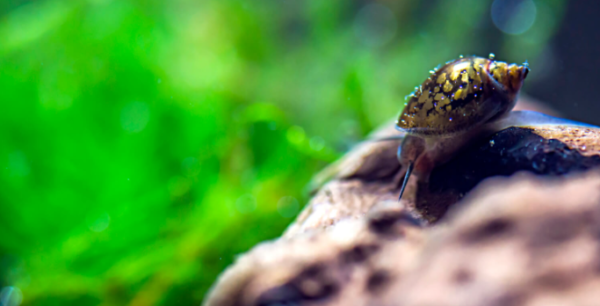
Although extending the life of a snail is extremely hard, you can certainly reduce it with subpar care.
Aquarium Snail Size
An average mature aquarium snail can easily grow up to 2 inches in diameter. Certain species of pond snails can even become as big as 3 inches in diameter. On the other hand, if your snail doesn’t receive the required care, it can have stunted growth. So, pay close attention to how it’s growing to know whether your snail is healthy or not.
Aquarium Snail Natural Habitat and Origin
Aquarium snails inhabit the freshwaters of South American countries like Peru, Bolivia, and Brazil. At the same time, they are also a common species in the British Isles, mainly England and Ireland. You can also find them extensively across Asia, Canada, New Zealand, North America, and Tasmania.
Aquarium Snail Care & Tank Set-Up
Aquarium Snail Tank Size and Specifications
Optimum Tank Size for Aquarium Snail
Unlike other creatures in your aquarium, these snails don’t get too long. Typically they remain around 1-3 inches in diameter. So, it’s better to keep them in smaller tanks. The ideal recommendation would be a 1-gallon tank. However, for a community tank, try one in the size of 5-10 gallons. They should be more than happy there.
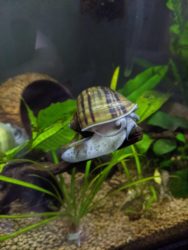
Tank Shape for Aquarium Snail
Snails are one of the most resilient creatures and aren’t picky about the vessel you keep them in.
Filter Type
Once again, when it comes to aquarium snails, they don’t make any complaints. These are extremely hardy creatures and can sustain in almost any water. However, considering they are freshwater species, installing a sponge filter in your tank is advisable.
They don’t require any heaters or pumpers, so there is no need to worry about that. Even a filter is not mandatory. If you change the water every few weeks, they’ll be happy.
Substrate
An important point to remember when picking the substrate for your aquarium snail is bottom feeders. Sand can be a popular choice for fish, but snails aren’t the case. As the fine particles of the sand hinder their movement.
Instead, try to mimic their natural habitat in your tank. That includes introducing gravels or pebbles so that they can move around freely at the bottom. However, make sure to include anything large. Try to keep the pebbles smaller than your snails.
Water Parameters for Aquarium Snails
Aquarium snails are resilient, but they still need clear and clean water to have a healthy life. That’s why it’s very important to look into the water requirements of your snails.
Water Temperature
Aquarium snails don’t have the strictest water needs. Pond Snails can usually survive very well in tanks with temperatures between 32-90℉, while for other species like mystery snails, that number is around 60-80℉
Ph Level
Freshwater snails prefer slightly alkaline water. As long as you keep the pH anywhere between 7 to 9, you’re good to go.
Water Hardness
While aquarium snails can live in soft water, it’s better not to keep them there for long. The species prefers slightly hard water and thrive in water with hardness between 8-13 dGH.
Aquarium Snail Landscape
Best Plants for Aquarium Snail
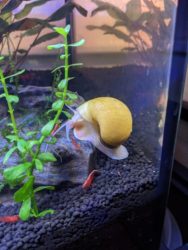
Remember, snails like plants too much on plants. Chances are you won’t have many plants left if you put any in the fish tank. But, if you’re fine with it, try introducing java moss, anubias, or hornwort.
Worst Plants for Aquarium Snail
There are no bad plants for your snails. They can feed on almost any plant, as long as they aren’t very hard.
Decorations For Aquarium Snail
Tank decor isn’t a big concern for aquarium snails. These creatures are inhabitants of slow-moving, dark, and swampy waters. Imitating a similar environment within your tank is a good way of keeping them happy.
Lighting For Aquarium Snail
Most snails prefer a dark or dimly lit tank. Thus, you don’t need to introduce any artificial light in the tank. Give them a dark corner, and they’ll be pleased.
Aquarium Snail – Pests or Pets?
Anyone with experience in the realm of aquariums will have some preconceived notion in regards to aquarium snails.
While some may be on point, there are no doubt others that are unfounded.
It is true that snails have been known to be a nuisance towards plants and can interfere with the intake on pumps and filters.
However, they can serve beneficial purposes as well; one of the most common benefits they provide is as a cleaning crew.
Snails are notorious scavengers and will eat detritus that winds up at the bottom of the tank, en route to your filter, negatively impacting the tank’s water quality along the way.
Feeding Aquarium Snails
Best Diet for Aquarium Snails
Feeding your snails isn’t as taxing as some other aquatic creatures. They tend to love feasting on dead or decaying matter. They are omnivorous and can easily sustain debris, dead plants, fish food, and everything in between. However, don’t leave out unfinished food in the tank. That’ll degrade the water quality.
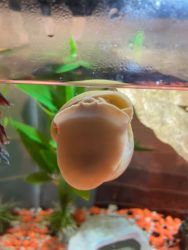
Placing ample vegetation in the aquarium is yet another way of taking care of their nourishment. They’ll feed on anything that grows naturally. That includes leafy or blanching vegetables.
By far, the favorite food for snails is the algae that develop on the rocks or walls of the tank. You’ll find them devouring the algae all day long. If there isn’t much to go around, you can also introduce fresh algae by sinking algae pellets in the tank. Aquarium snails prefer algae in their diet.
How Often Should You Feed Aquarium Snails?
It’s hard to keep track of your snail’s diet. They’re scavengers and find food for themselves with ease. However, you should always be careful of overfeeding them. That’ll definitely lead to a full-scale outbreak.
Aquarium Snails Behavior and Temperament
Aquarium Snails are a peaceful bunch of creatures and can live cordially with many tank mates.
They are also extremely shy and easily scared. Amid a dangerous stimulus, they’ll often retract within their shells and eject blood as a trigger response. Some snails, like pond snails, are also known to be cannibalistic and attack their fellow mates.
Are Aquarium Snails Lone or Societal in Nature?
Most aquarium snails are extremely calm and have no issues living with bigger snails or fish. They can be very good companions and co-exist peacefully with other creatures in the tank.
To Snail or not to Snail
Different species of snails will naturally have different diets.
Some, as mentioned previously, will definitely scavenge for whatever food they can find.
This would include dead or dying plant matter, algae, dead fish, uneaten fish food, and fish droppings.
This is obviously beneficial as it positively impacts your tank’s water quality.
The snails eat detritus and other unwanted materials, which keeps harmful chemicals, such as nitrites and ammonia, from accumulating.
On the other end of the spectrum are snails that are carnivores; these species typically feed on smaller aquatic animals including fish eggs.
This is an important distinction to keep in mind before introducing snails into your aquatic environment.
Beneficial Aquarium Snails
While there are dozens of beneficial species of aquarium snails there are some better-known varieties such as the apple snails, trumpet snails and nerite snails.
The Apple Snails
The Apple Snail comes in a rainbow of colors including zebra-like patterns, as well as blues and golds.
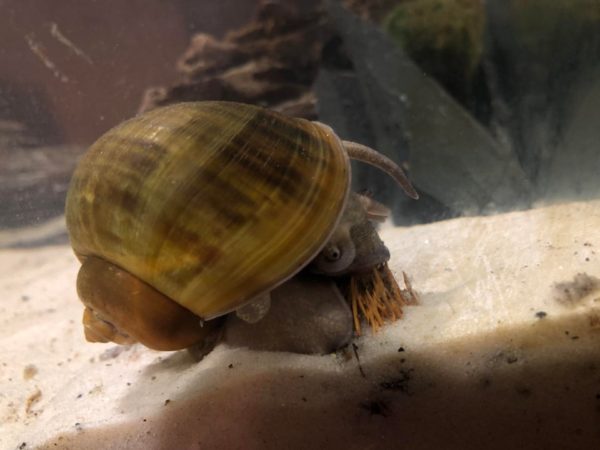
These particular snails can grow up to half a foot in diameter and are known to be quite prolific when it comes to breeding.
Considering those two facts, they might be best for larger tanks.
Apple Snails have also been known to eat aquarium plants when they get hungry so make sure to keep them on a regular feeding schedule if at all possible.
Read more about the apple snails here.
One thing to watch out for with these snails is how violently they destroy plant life. The rest of the snails on our list are more passive, preferring to munch on the epithelium that grows on each stem, but the Apple Snail will attack the plant directly.
This implies that if you wish to mix them with plants that aren’t as hardy, you’ll have to choose between the two. If you enjoy aqua scaping, this is not the snail for you.
Many aquarists feed them a normal plant-based fish diet to keep their appetites in check. They are significantly less likely to attack the plants in your tank when they are not hungry (not exactly rocket science).
The Apple snail is available in various hues, including zebra-like patterns, blues, and golds. These snails may grow up to half a foot in circumference and are known to be extremely prolific breeders.
The Trumpet Snails
Trumpet Snails are considered quite pleasing to the eye. Some aquarists love trumpet snails, while others dislike them. This is due to their capacity to increase swiftly and take over a tank if uncontrolled.
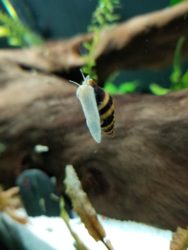
However, they’re fantastic freshwater snails to have in your aquarium because of their unique appearance and the benefits they provide.
Like the Apple Snail, they come in a wealth of color options.
Unlike the Apple Snail they tend to feed mostly on detritus.
It is not uncommon to see a Trumpet Snail dig through a substrate layer to feed on the leftover food and waste products that float down to the bottom of the tank.
They are mostly nocturnal and are generally considered to be great “neighbors” in almost any aquarium.
This species requires little maintenance and is simple to care for. As long as everything is pretty constant, you won’t have to worry about them thriving in your tank. They don’t bother other animals and prefer to be alone.
They aren’t particularly large (about an inch long), making them appear more “natural”. Something about having a couple of them in your aquarium makes it appear as if you’re looking into a pond.
Because of their modest size, you’ll need to exercise caution when it comes to filtering power. A powerful filter can easily suck them in. If you can’t manage the intake, we propose putting a filter or guard in front of it to keep it from getting stuck.
If you want to learn more about the trumpet snails, click here.
The Nerite Snails
Another pretty, yet functional snail is the Nerite.
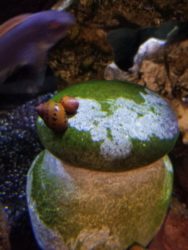
Typically measuring between a half and a full inch, the small guys are a big help when it comes to one potential aquarium pest: algae!
The Nerite snail is renowned for eating algae off of almost any surface in the aquarium.
Nerite snails are adaptable to water requirements and can fit into relatively tiny aquariums (this species rarely grows larger than one inch in diameter).
The shell patterns on this snail is its best feature. On their shells, you’ll find a variety of fascinating and exquisite designs that are just mesmerizing to look at.
The majority of the hues are yellow or brown, although there are a variety of other alternatives seen in their patterns. These snails thrive in planted aquariums with sand as a substrate. This will protect their tender undersides from scrapes and infection.
They are also known to be escape artists, depending on the layout of the tank, so if you see one that has escaped, get it back in the tank as soon as possible.
Not So Beneficial Aquarium Snails
Some other snails should probably be avoided in the world of aquarium hobbyists.
Similarly to their beneficial brethren, they range from merely a nuisance to being downright destructive.
The Pond Snails
The pond snail is a prime example of a bad snail for your tank.
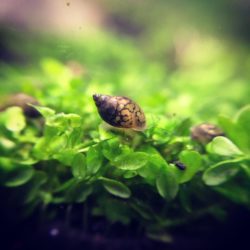
Measuring up to only a quarter of an inch, they are able to hide in all sorts of nooks and crannies, which is not a deal-breaker.
However, when you couple that with the fact that they are notorious for reproducing, you could have a problem on your hands.
Some innocent overfeeding will turn these natural scavengers into grade A pests!
The Ramshorn Snails
Another entry for the most (un)-wanted list is the Ramshorn snail.
Available in a variety of colors including pink, red, blue, and brown, this snail is named for the horn-like shape of the shell it lives in.
This snail gets its bad rep from management issues, too; if overfed, this species is likely to reproduce with wild abandon.
Aquarium Snails Tank Mates
Ideal Aquarium Snails Tank Mates
Some of the best tank mates for aquarium snails are:
- Bamboo Shrimp
- Dwarf Shrimp
- Rasboras
- Neon Tetras
- Cherry Barbs
- Fancy Guppies
- Rabbit snails
- Cardinal Tetras
- African Dwarf Frogs
Bad Tank Mates for Aquarium Snails
Some of the worst tank mates to pair with aquarium snails are:
- Clown Loaches
- Yo-yo Loaches
- Skunk Loaches
- Freshwater Pufferfish
- Dwarf Puffer
- Betta Fish
- Bala Shark
- Gourami
Breeding Aquarium Snails
Most aquarium snails are hermaphrodites. That means they have mixed mating partners and can often cross or self-fertilize. An adult snail can take up either mating roles and reproduce sexually or asexually. The former is the preferred choice.
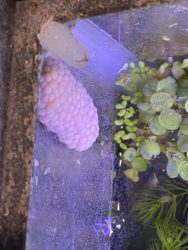
During the process, the younger snail generally takes up the male role while the older one adopts the female role. That’s because older snails can produce a greater number of eggs. Moreover, the prostate gland in younger snails also increases quicker.
After mating, the female generally lays her eggs in a cocoon on the water’s surface. It takes roughly a month before the eggs hatch. If you want to control the breeding, remove the cocoon from the water to control the snail population.
On the other hand, to encourage breeding, leave enough headspace above water for females to lay their eggs. Also, don’t forget to focus on the diet of your snails during this time. The babies will come out when the eggs mature and tend to themselves.
Aquarium Snails Breeding Level
Easy
Aquarium Snails Sexual Dimorphism
Snails are hermaphrodites. That’s why you are likely to find both male and female reproductive organs
Aquarium Snails Common Diseases and Their Treatment
Aquarium Snails are extremely resilient. However, like any other aquatic creature, they have a few vulnerabilities.
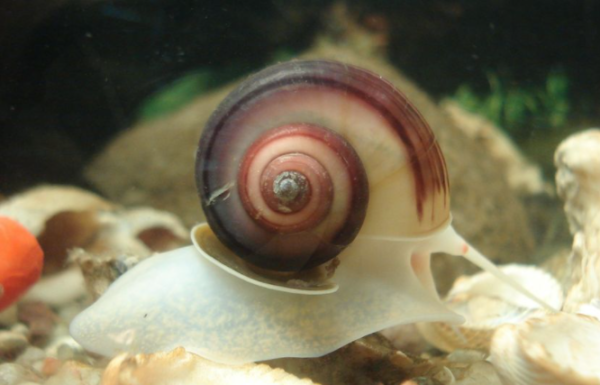
Firstly, they’re sensitive to any sudden change in water. A drastic change in conditions might lead to various diseases and distress to the snails.
Parasitic Infections
Parasitic infections might be a result of poor care. Unsuitable water conditions can affect your snails severely. It’s hard to treat the disease and can even lead to premature death.
Shell Deformity
Shell deformity might directly consequence low pH levels in the water. It might also lead to tiredness in your creatures and make them float for longer in the water.
Calcium Deficiency
Calcium deficiency is often rampant among most aquarium snails. Luckily, it can be fixed pretty easily. Introducing calcium powder or supplements like cuttlebone in the water can help.
Facts About Aquarium Snails
- Pond Snail is the biggest among freshwater snails
- Some snails can be cannibalistic
- Most of them scuttle inside their shells when threatened
- Some of them also come to the surface for breathing
- They prefer slow-moving or stagnant water
FAQs
What Do Freshwater Snails Eat?
Freshwater snails devour algae and leftover fish food in aquariums.
Snails In Aquaculture Survive for How Long?
Aquarium snails have a 3–10-year life span, depending on their species and the aquarium’s water quality.
What Types of Freshwater Snails Can I Keep in A 5-Gallon Or 10-Gallon Tank?
Most freshwater snails (such as the Mystery snail, Malaysian Trumpet snail, Ramshorn snail, and Assassin snail) will flourish in a tank of 5 to 10 gallons.
Will Freshwater Snails Consume the Tank’s Live Plants?
Several species can be kept securely with plants. Snails, on the other hand, eat healthful diets. These snails are considered pests and are prohibited in many nations worldwide.
Is It Necessary for Aquarium Snails to Have Access to Oxygen?
Yes, they require oxygen, just like any other living organism.
Is It Possible for Freshwater Snails to Live in Brackish Water?
The species determine it. Nerite snails, for example, can survive and grow in brackish water. Some can even survive in deep waters.
Conclusion
As we’ve seen, some snails are very beneficial, while others can be quite annoying.
When you combine those advantages with ease of care, there’s simply no reason not to get some. Nothing should hold you back unless you already have an inappropriate tank mate (something that eats snails).
Remember that some on the “bad” list receive a reputation that really has more to do with their owner’s actions than their own behaviors.
Now that you’ve learned about all of the best varieties of aquarium snails, it’s time to determine which ones you prefer. Once you find an aquarium snail that interests you, make sure to research all aspects of its behavior and requirements to see if it will fit in with your tank.
No related posts.

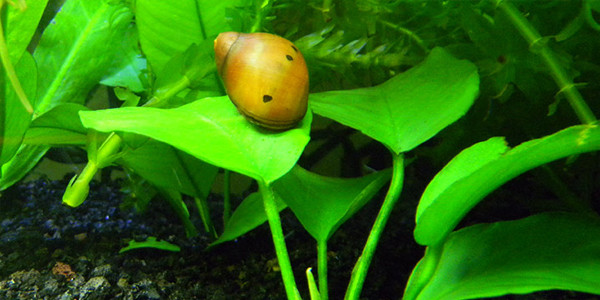
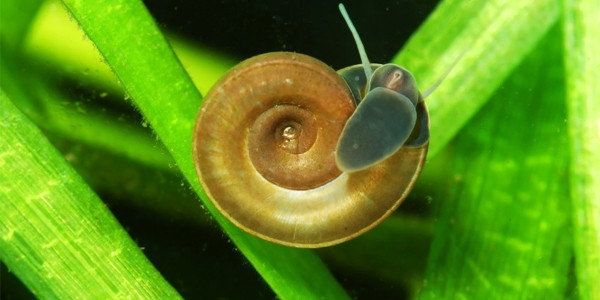
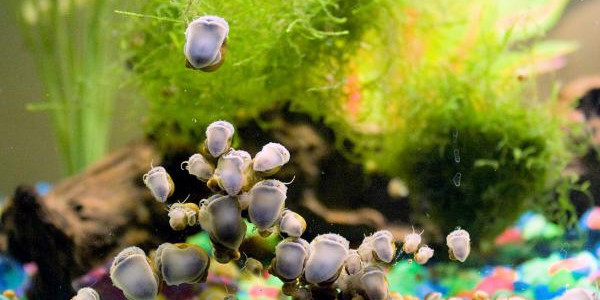
2 thoughts on “Freshwater Aquarium Snails: Complete Guide to Care, Breeding, Tank Size and Disease”
I put my extra snails on a farm near our house, that will give them enough food source through out the year.
That’s nice. Some of us are not as lucky as to having a farm nearby. =p